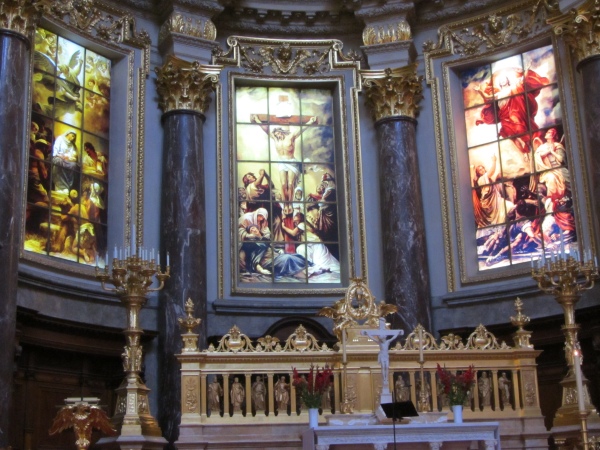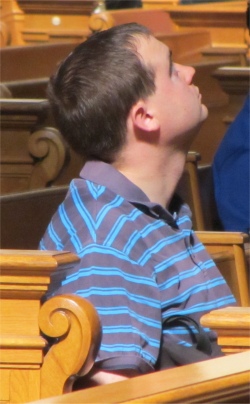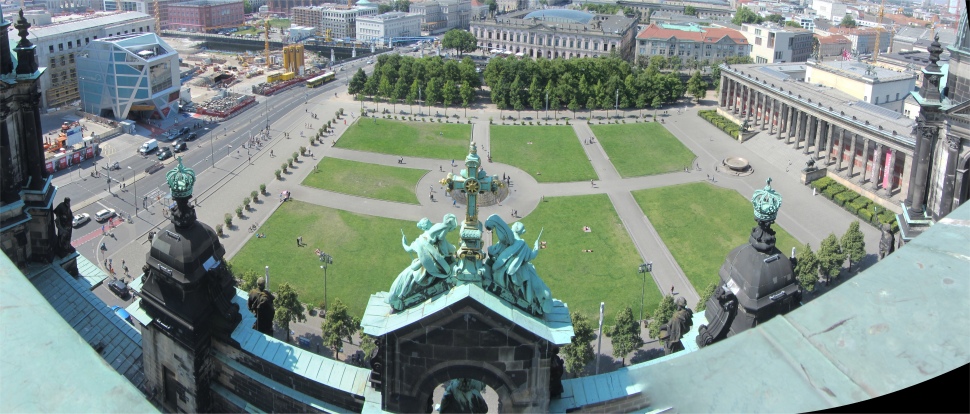The powerful and radiant effect of the magnificent, 70 meter high dome was captivating, causing every visitor to pause in reverence on entering the Cathedral. Flooded with light, the dove represents the presence of the Holy Spirit. The dome mosaics portray the beatitudes from the Sermon on the Mount. Each of the famous dome mosaics is 39 square meters large and comprised of over 500,000 tiles in approximately 2000 different shades of colour.

St Marienkirche
|
The Hohenzollern Crypt in the Cathedral of Berlin is of tremendous historical and cultural significance. It contains 94 entombments from the end of the 16th century until the beginning of the 20th century. Together with the stately sarcophagi and burial monuments in the sermon church, these document five hundred years of Brandenburg-Prussian burial culture. It was an impressive collection, but it left me somewhat cold; perhaps it reminded me that I have reached the fag end of life.
Of course no trip to the Dom would be complete without a climb up the 270 steps to the outer walkway of the dome. Below us lay Museum Island, the Palace Square, and Lustgarten. Beyond that magnificent panoramas included the golden dome of the synagogue, Gendarmenmarkt, Nikolaiviertel, the Reichstag, and the Rotes Rathaus. It is well worth the climb.
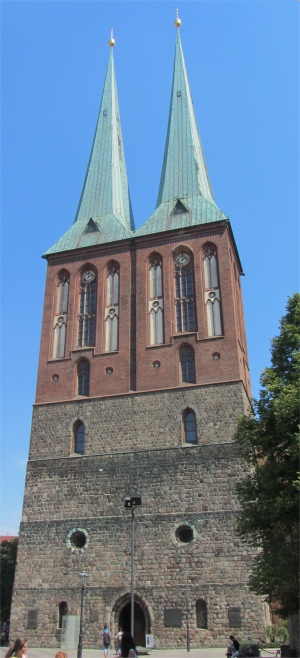
Nikolaikirche
|
After we had exhausted the Dom, we agreed to split up. Rex and Meryl intended to visit the Oberbaumbrücke and the East Side Gallery, a 1316m long remnant of the Berlin Wall that has been turned into one large open-air gallery containing 106 paintings. Dan and I had seen these two sights eight years earlier.
So, Dan and I planned to take a trip to the top of the Fernsehturm (T.V. Tower); that would definitely not appeal to Rex since he has a fear of any height greater than mast height. It was only after buying the tickets that we learned we would have to wait two hours. Time to kill time we thought.
We decided to visit the Nikolaiviertel. Just outside the tower, a large crowd of Islamics had assembled by the Rathaus (town hall), and were just starting a city march complete with banners and chants. I never did find out what the issues were here, but there was a very large police presence, and many roads were closed off.
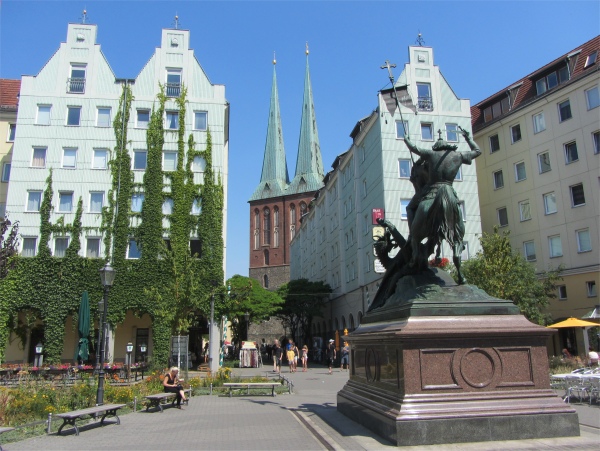
Looking along Propststrasse towards Nikolaikirche, George Getting Stuck into the Dragon
|
Nevertheless, we made it to the Nikolaiviertel or St. Nicholas Quarter, a small neighbourhood in the historic centre of Berlin. It is the site of Berlin's founding and home to the city's oldest church, the Nikolaikirche. The quarter occupies the area where Berlin was first founded in the early 13th century. The area, which borders the Spree river, contained some of the oldest buildings in Berlin. Until World War II, the district was characterised by inns, stores, farms and small businesses. Artists such as Kleist, Hauptmann, Ibsen, Casanova, Strindberg or Lessing either lived or stayed here. The area, however, was largely destroyed by bombing in 1944 and for a long time it laid in ruins.
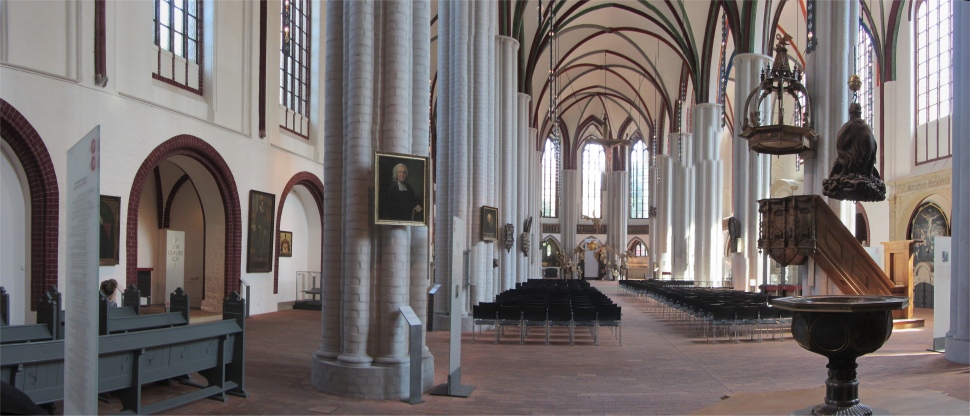
Inside Nikolaikirche
|
After the war Nikolaiviertel became part of East-Berlin. It wasn't until 1979, in the run-up to the 750th anniversary of the city, before reconstruction of the area started. During the eight-year project, replicas of historic buildings were constructed in an attempt to recreate a historic quarter. It was sometimes scornfully nicknamed "Honecker's Disneyland" due to the unorthodox way in which the restoration took place. Almost none of the buildings were built at their original location. The result is nonetheless a nice tourist-attracting area with many restaurants and cafés.

Karl Marx (left) and Friedrich Engels
|
We made our way to the centre of the Nikolaiviertel where we found the Nikolaikirche, the oldest church in Berlin, which gave the quarter its name. The church dates all the way back to the early days of Berlin. It was probably built shortly after Berlin was granted town privileges. The building has undergone much reconstruction over the centuries. A presbytery was built in 1402 and the two towers were added in 1877. The Nikolaikirche was destroyed in 1945 by bombing and completely rebuilt in 1987. The church now houses a museum recounting the history of the city. It was a lovely, light building inside with a light pastel colour scheme to match the setting; quite beautiful.
Gabled buildings around the quarter reminded me of the Netherlands, and together with the oldy-worldy pubs, cafes and restaurants, I could see why it has become a popular part of a tourist's itinerary.
We followed the Nikolaiviertel with a quick walk around the Museuminsel, passing through the spacious garden in front of the Dom, the Lustgarten. The garden was originally created as an exotic garden for Princess Luise, spouse of the Great Elector. King Frederick William I, the so-called "Soldier-King", turned the garden into a military parade ground. In 1997 the garden was laid out to a 19th century design by Schinkel. As part of the remodelling, a modern fountain was installed in 2000 in the middle of the garden. The fountain, designed by Hans Loidl, spouts water up to ten meters high and attracts the attention of passers-by, particularly today due to the scorching heat.
An interesting aspect was the huge Graniteschale (granite bowl) in front of the Altes Museum. It was commissioned in 1826 by King Frederick III and was created from a large, 700 tonnes, red granite rock found just outside Berlin. The bowl was designed by Christian Gottlieb Cantian in the style of the great porphyry bowl from Emperor Nero's Golden House (now on display in the Vatican Museums). When it was completed in 1828, it was the world's largest bowl, measuring 6.91m in diameter and weighing over seventy tonnes. It was to be placed in the rotunda of the Altes Museum but due to a miscalculation the bowl was too large so instead it was placed outside.
The history of Museum Island started with King Frederick William III who, in 1810, commissioned the creation of a public museum on Spree Island. In 1822 Karl Friedrich Schinkel drew up plans to develop the island, and a first museum building, the Royal Museum (now the Altes Museum) opened in 1830. The museum was built to allow the general public to view the royal art treasures of Prussia. It was the first such museum in the country. But the idea for a museum island wasn't devised until around 1841, when Friedrich August Stüler proposed the idea to create a cultural centre on the island, which was lauded by all. The architect also designed the Neues Museum (New Museum), which opened in 1859 as the Royal Prussian Museum.
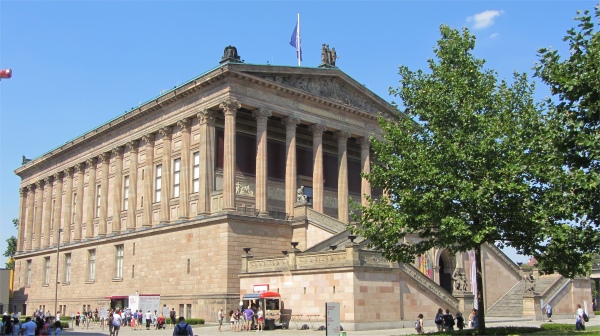
Alte Nationalgalerie on Museuminsel
|
The year 1876 saw the completion of the Alte Nationalgalerie (Old National Gallery). The Kaiser-Friedrich Museum (today the Bode Museum) was added in 1904 and the final museum, the Pergamon, was completed in 1930. Sadly, nearly 70% of the buildings were destroyed during World War II and, after the war, the collections were split up between East and West Berlin. After German reunification the collections were brought together again and a masterplan was drawn up designed to not only restore all five museums but also expand and modernize the museum complex as a whole.
We strolled around the island, but time did not permit us to visit any of the museums, we had to return to the Fernsehturm for the appointed hour. After a quick security check, we shot up 203m to the viewing platform at a dizzying speed. The Fernsehturm or the Tele-spargel is one of the tallest structures in Europe. The total height to the top of the spire is 365m. It was built in 1969 by a team of architects with the help of Swedish experts. It consists of a concrete shaft, a steel-clad metal sphere and a TV antenna. A revolving restaurant (Telecafé) is also sited in the sphere.
The views from here were stunning. Whereas from the Dom viewing gallery we could see structures on the horizon, here we now looked down on those same structures, and the horizon shifted into a hazy, blue, fuzzy outline that melted into the blue sky. As well as the vast city spread below us with its arterial waterways meandering through it, we gazed down onto two airfields, Tempelhof and Tegel, and watched planes land and take off. It was an ideal place to sit down and sip a cold beer, so ideal in fact that we did, and watched the city go about its business far below us.

Cheers from the Fernsehturm
|
Having had our fill of views, we headed down to one of the many cruise boat jetties, and within 10 minutes we were gliding along the River Spree, listening to a mixed German/English commentary provided by a young chap, probably a student, about areas and buildings we were passing. The hour trip was well worth the money spent and an ideal way to see the city without trudging for miles and miles, indeed a lovely way to wind down after hours' worth of sight-seeing.
We caught a train back to the hotel, had a quick shower, and re-joined Rex and Meryl. Unanimously we decided to eat out in Nikolaiviertel, and to save a lengthy walk, we would catch trains there and back. As we left the hotel to cross the large square to the Central Station, we found ourselves surrounded by a large police presence. Near the hotel, on a small podium, a fellow was shouting out through a tannoy to a motley collection of about thirty people who occasionally applauded him. 80m further across the square, behind a heavily policed barrier, thirty or so people shouted and jeered back at the small group in front of us. I asked a nearby policeman what all the commotion was about. The nearest group listening to the man on the tannoy were demanding that Germany should take no more refugees. The group behind the barrier were the opposition. The police outnumbered the lot of them by about three to one.
In a short time we were strolling through Nikolaiviertel again. Rex and Meryl had also been here earlier today, having decided not to go out as far as Oberbaumbrücke and the East Side Gallery.
Down by the sparkling river, at the Villi restaurant, we drank and ate our last evening meal in Berlin. It was a gorgeous setting, with the Dom just a short distance down the river. Sadly our waiter was not so gorgeous. His mission in life was to rush us through our decision making process and meals; perhaps he wanted to get home early to watch his favourite soap opera, East Enders or perhaps East Berliners since we were in Berlin. Despite all this, we displayed true British grit and progressed at our own tempo. The food was good mind you, and so was the ale.



